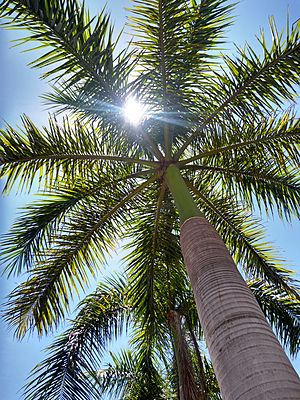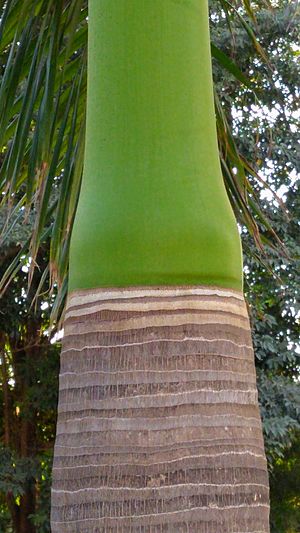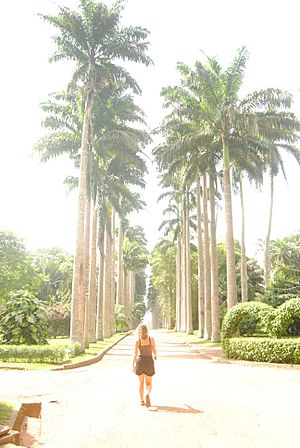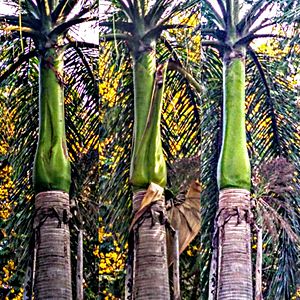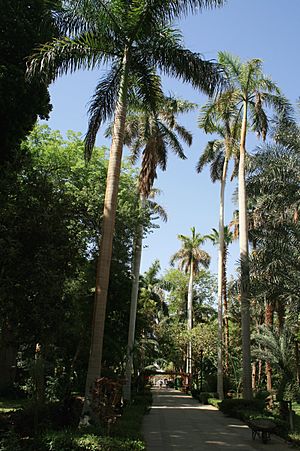Royal palm facts for kids
Quick facts for kids Royal palm |
|
|---|---|
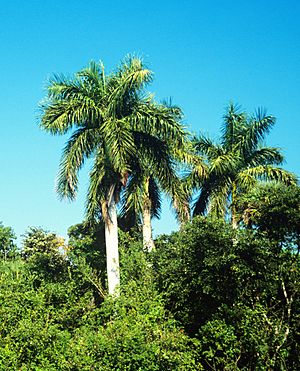 |
|
| Native habitat in Collier-Seminole State Park, Florida | |
| Scientific classification | |
| Genus: |
Roystonea
|
| Species: |
regia
|
| Synonyms | |
|
Oreodoxa regia Kunth |
|
The Cuban royal palm (Roystonea regia) is a tall and beautiful palm. It grows naturally in Mexico, parts of Central America, the Caribbean, and southern Florida. People have planted this attractive palm all over warm, tropical places as an ornamental tree.
This palm can grow very tall, from 50 to over 80 feet! For a long time, palms in Cuba and Florida were thought to be different species. But now, scientists agree they are all the same species.
The royal palm is best known for its beauty. But it's also used for thatch (roofing material) and wood for building. Its fruit is a food source for birds and bats, which help spread its seeds. Animals also visit its flowers. The Roystonea regia is the national tree of Cuba. It also plays a role in some religions, like Santería and Christianity, where it's used on Palm Sunday.
Contents
What Does a Royal Palm Look Like?
The Roystonea regia is a very large palm. It can reach heights of 65 to 100 feet (20 to 30 meters). Its trunk is about 1.5 feet (47 cm) wide. The trunk is strong, very smooth, and grey-white. It has a noticeable bulge below a bright green part called the crownshaft.
These trees usually have about 15 leaves, which can be up to 13 feet (4 meters) long. The flowers are white with a pinkish color. The fruit is round or oval, about 0.3 to 0.6 inches (8.9 to 15 mm) long. They start green, then turn red, and finally purplish-black when they are ripe.
Scientists have found special root nodules on R. regia trees in India. These nodules contain tiny bacteria called Rhizobium. These bacteria usually help plants like beans get nitrogen from the air. This was the first time such nodules were found on a palm tree. This means royal palms might also be able to get nitrogen this way, which helps them grow.
How Royal Palms Got Their Name
Scientists group living things into families and tribes. The Roystonea palm belongs to the Arecoideae subfamily.
The first description of this palm was in 1791 by an American scientist named William Bartram. He called it Palma elata. He saw these trees growing in central Florida. Later, in 1816, a German botanist named Carl Sigismund Kunth described the same species from Cuba. He called it Oreodoxa regia.
To clear up confusion, an American botanist named Orator F. Cook created a new group (genus) called Roystonea. He named it after an American general, Roy Stone. Cook then renamed Kunth's species Roystonea regia. This is the name we use today.
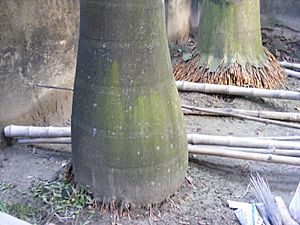
Cook thought the Florida palms were different from the Cuban ones. He called them R. floridana. But now, scientists agree that the Florida and Cuban palms are the same species, R. regia.
Sometimes, the oldest name given to a species should be the correct one. Bartram's name, Palma elata, was older. But the name R. regia had been used for a very long time in gardening and by people all over the world. Because of this, scientists decided to keep the name Roystonea regia to avoid confusion.
Common Names
In places where it's grown, Roystonea regia is often called the Cuban royal palm or just the royal palm. In Cuba, people call it palma real or palma criolla. In India, it's known as vakka. In Cambodia, where it's planted along streets, it's called sla barang, which means "Western palm."
Life Cycle of the Royal Palm
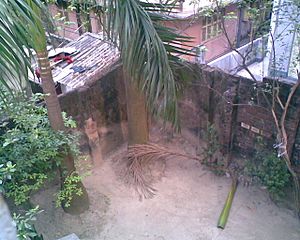
Royal palms have separate male and female flowers on the same tree. Animals help them reproduce. European honey bees and bats are known to pollinate the flowers. Birds and bats eat the fruit, which helps spread the seeds to new places.
When a royal palm seed sprouts, only a part of the tiny plant inside pushes out of the seed. The new seedling grows right next to the seed. In cultivated areas, young palms start growing a stem about two years after sprouting. This happens when they grow their thirteenth leaf. In Florida, young palms grow about 1.6 inches (4.2 cm) taller each year.
Where Do Royal Palms Live?
Roystonea regia is found naturally in Central America, Cuba, the Cayman Islands, Hispaniola (which includes the Dominican Republic and Haiti), the Lesser Antilles, The Bahamas, southern Florida, and parts of Mexico.
Today, royal palms are planted in warm, tropical, and subtropical areas around the world. You can find them in the United States (especially central and southern Florida, Hawaii, Puerto Rico, and South Texas), Australia, Brazil, and parts of southern Asia. They are also popular ornamental trees in the Canary Islands.
Royal Palms and Other Living Things
The leaves of Roystonea regia are used by the Florida bonneted bat (Eumops floridanus) as a place to rest. Cuban tree frogs also use them as a hiding spot in Florida. In Panama, yellow-crowned parrots build their nests in the trunks of these palms.
Bees visit the flowers of R. regia to collect pollen and nectar. Bats also feed on the pollen and nectar. Fruit-eating bats and birds like the Jamaican fruit bat and the social flycatcher eat the palm's fruit.
The royal palm can be affected by certain insects and diseases. The royal palm bug (Xylastodoris luteolus) feeds on it in Florida. Some butterflies use it as a host plant for their caterpillars. The palm can also get diseases like bud rot, caused by a water mold, and other fungal infections.
In some places, like Panama, where it's not native, Roystonea regia is considered an invasive species. This means it can spread quickly and sometimes outcompete native plants.
How People Use Royal Palms
People plant Roystonea regia all over warm regions because it's a beautiful ornamental tree. The seeds can be used to make oil and as food for farm animals. The leaves are used for thatching roofs, and the wood is used for construction.
The roots of the royal palm are sometimes used in traditional medicine. For example, they are added to a Haitian drink called tifey by Cubans of Haitian origin. They are also used as a traditional treatment for diabetes. However, there is currently no strong scientific evidence to support these uses.
Fibers from the palm's leaf sheath are similar to other strong plant fibers. They are also lighter, which means they could be useful for making lightweight materials. Scientists are also studying an extract from R. regia fruit called D-004. This extract, a mix of fatty acids, is being looked at as a possible natural treatment for an enlarged prostate in men.
Royal Palms in Religion
The Roystonea regia is very important in popular religions in Cuba. In Santería, it is linked to the gods Shango or Aggayú. It also has special meaning in the Palo faiths and the Abakuá group. In Roman Catholicism, the royal palm is an important part of Palm Sunday celebrations.
See also
 In Spanish: Roystonea regia para niños
In Spanish: Roystonea regia para niños


